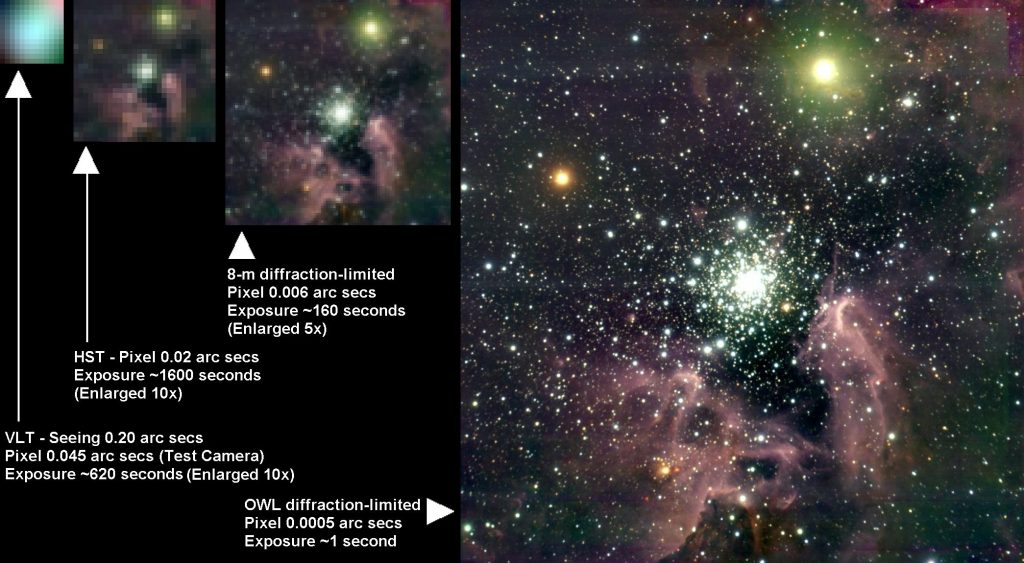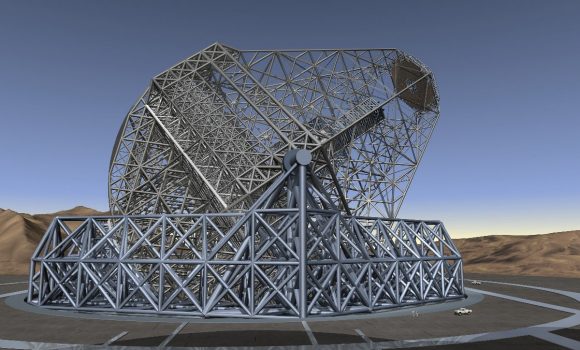We humans have an insatiable hunger to understand the Universe. As Carl Sagan said, "Understanding is Ecstasy." But to understand the Universe, we need better and better ways to observe it. And that means one thing: big, huge, enormous telescopes.
In this series we'll look at 6 of the world's Super Telescopes:
- The Giant Magellan Telescope
- The Overwhelmingly Large Telescope
- The 30 Meter Telescope
- The European Extremely Large Telescope
- The Large Synoptic Survey Telescope
- The James Webb Space Telescope
The Overwhelmingly Large Telescope
The OWL (Overwhelmingly Large Telescope) was a gargantuan telescope proposed by the European Southern Observatory (ESO). The OWL was going to be a 100 meter monstrosity, which would dwarf anything in operation at the time. Sadly, OWL was eventually cancelled.
For now, anyway.
At the time that OWL was first proposed—in the late 1990's—scientific studies showed that huge telescopes would be necessary to advance our knowledge. OWL promised to help us unlock the mystery of dark matter, peer back in time to witness the birth of the first stars and galaxies, and to directly image the atmospheres of exoplanets. It's easy to see why people were excited by OWL.

This image simulates the increased resolving power of the OWL compared to its contemporaries. Image: ESO Telescope Systems Division
By 2005, the OWL study was completed and reviewed by a panel of experts. At that time, the concept was validated as a cost-effective way to build an Extremely Large Telescope (ELT). However, as the wheels kept turning, and a price tag of € 1.5 billion was attached to it, the ESO backed away.
OWL's design called for a 100 meter diameter mirror, built out of 3264 segments. It would have had unequalled light-gathering capacity, and the ability to resolve details down to a milli-arc second. (A milli-arc second is approximately the size of a dime, placed on top of the Eiffel Tower, and viewed from New York City.) That's extremely impressive to say the least. And OWL would have operated in both visible light and infrared.

Everything about OWL's design was modular, in an effort to keep costs down. Image: ESO Telescope Systems Division
The problem with OWL was the cost, not the design feasibility. Engineers still think the design is feasible. In fact, the construction of the mirrors was pretty well-understood, and perhaps the most challenging part of the OWL was the adaptive optics required.
It's a fact of large telescopes that they have to be constantly adjusted to produce sharp images. This requires adaptive optics. The adaptive optics required for OWL would have pushed the state-of-the-art technology at the time.
Adaptive optics is a method of overcoming the distortions that affect light as they pass through Earth's atmosphere. For extremely sensitive telescopes like the OWL, the atmosphere of Earth is problematic. The photons coming from the distant reaches of the Universe can be garbled by the atmosphere as they approach the telescope. Telescopes are built on mountain-tops to reduce how much atmosphere photons have to travel through, but that's not enough.
This video explains how adaptive optics work, and how they helped the Keck telescope make new discoveries.
OWL's mirror segments would have to be aligned to within a fraction of the wavelength (0.0005 mm for visible light) in order for the telescope to deliver good images. OWL's adaptive optics would have achieved this by adjusting each of OWL's 3264 segments rapidly, sometimes several times per second.
OWL's design called for modularity, or "serial, industrialized fabrication of identical building blocks" to reduce costs. The manufacture of extremely large telescopes is expensive, but so are the transportation costs. All of the components have to be built in engineering and manufacturing centres, then shipped to, and assembled on, fairly remote mountain tops. OWL's components were designed to be shipped in standard shipping containers, which simplified that aspect of its construction.
In fact, OWL could have begun operation before all of its mirrors were in place, and would have grown in power as more mirror segments were built and integrated. (Other telescopes, like the Giant Magellan Telescope (GMT) will be in operation before all of the mirrors are installed.)
In the end, OWL's cost became too great, and the project was cancelled. The ESO moved on to the 39.3 meter European Extremely Large Telescope. But all of the work done on the design of OWL was not lost.

This artist's impression shows the European Extremely Large Telescope (E-ELT) in its enclosure. The E-ELT will be a 39-metre aperture optical and infrared telescope sited on Cerro Armazones in the Chilean Atacama Desert, 20 kilometres from ESO's Very Large Telescope on Cerro Paranal, which is visible in the distance towards the left. The design for the E-ELT shown here is preliminary. ESO/L. Calçada
Everything that we learn about telescope design trickles down to our next-generation of telescopes. That's true whether designs like OWL get built or not. We'll just keep building on our success, and keep building larger and more powerful telescopes.
The adaptive optics that OWL required were a challenge. But huge advances have been made on that front. And in the way of things, the manufacturing costs have likely come down as well.
OWL itself may never be built, but other 'scopes are on the way. Telescopes like the James Webb Space Telescope, the Giant Magellan Telescope, and the European Extremely Large Telescope hold the same promise that OWL did.
And in the end, the contributions of those and other 'scopes might surpass those promised by OWL.
No comments:
Post a Comment